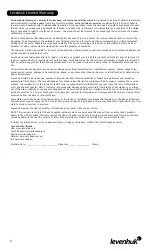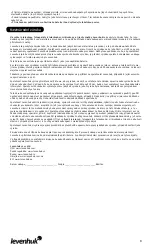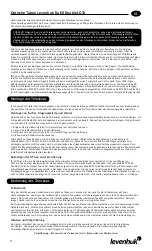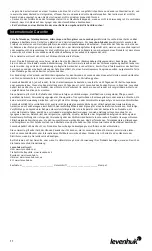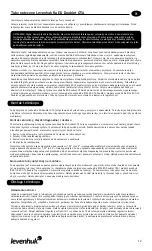
4
Care and maintenance
Batteries safety instructions
• Never, under any circumstances, look directly at the Sun through this device without a special filter, or look at another bright
source of light or at a laser, as this may cause PERMANENT RETINAL DAMAGE and may lead to BLINDNESS.
•
Take necessary precautions when using the device with children or people who have not read or who do not fully understand
these instructions.
•
Do not try to disassemble the device on your own for any reason, including to clean the mirror. For repairs and cleaning of any
kind, please contact your local specialized service center.
•
Protect the device from sudden impact and excessive mechanical force.
• Do not touch the optical surfaces with your fingers. To clean the telescope exterior, use only special cleaning wipes and special
optics cleaning tools from Levenhuk.
• Store the device in a dry, cool place away from hazardous acids and other chemicals, away from heaters, open fire and other
sources of high temperatures.
•
Replace the dust cap over the front end of the telescope whenever it is not in use. This prevents dust from settling on the mir-
ror or lens surfaces.
• Seek medical advice immediately if a small part or a battery is swallowed.
•
Always purchase the correct size and grade of battery most suitable for the intended use.
•
Always replace the whole set of batteries at one time; taking care not to mix old and new ones, or batteries of different types.
•
Clean the battery contacts and also those of the device prior to battery installation.
•
Make sure the batteries are installed correctly with regard to polarity (+ and -).
•
Remove batteries from equipment that is not to be used for an extended period of time.
•
Remove used batteries promptly.
• Never attempt to recharge primary batteries as this may cause leakage, fire, or explosion.
•
Never short-circuit batteries as this may lead to high temperatures, leakage, or explosion.
•
Never heat batteries in order to revive them.
•
Remember to switch off devices after use.
•
Keep batteries out of the reach of children, to avoid risk of ingestion, suffocation, or poisoning.
Astrophotography
Most CCD cameras have a 1.25” or 2” barrel. Simply insert the nosepiece of the CCD camera or the adapter into the focuser and
lock it place with two thumbscrews.
To attach a DSLR camera, you will need an appropriate T-ring and a camera adapter. Simply attach the T-ring to the camera body
and thread the camera adapter onto the T-ring. Insert the barrel of the camera adapter into the focuser and secure it in place
with two thumbscrews.
You may want to consider using a remote shutter release instead of the shutter release on the camera. Touching the camera may
shake the instrument and blur the resulting image. Also, make sure the tripod is steady.
Specifications
Model
Levenhuk
Ra R66 ED
Doublet
Carbon OTA
Levenhuk
Ra R80 ED
Doublet
Carbon OTA
Levenhuk
Ra R72 ED
Doublet OTA
Levenhuk
Ra R80 ED
Doublet OTA
Levenhuk
Ra R90 ED
Doublet OTA
Levenhuk
Ra R110 ED
Doublet OTA
Levenhuk
Ra R120 ED
Doublet OTA
Optical design
achromatic refractor (2-element lenses)
Optical tube ma-
terial
carbon fiber
metal
Objective lens
diameter, mm
66
80
72
80
90
110
120
Focal length, mm
400
500
432
500
500
770
900
Focal ratio
f/6
f/6.25
f/6
f/6.25
f/5.5
f/7
f/7.5
Optics material
ED glass
Optics coating
fully multi-coated
Focuser
2'' dual-speed Crayford
3'' dual-speed
Crayford
Tube-mount as-
sembly system
mounting bracket (screw connector)
Vixen-type
dovetail
mount, tube
rings (avail-
able in the
package)
screw connec-
tor, tube rings
(available in
the package)
Optical tube diam-
eter, in / mm
3.2 / 80.5
4.0 / 100.5
3.6 / 90.5
4.0 / 100.5
4.7 / 120
5.8 / 146
5.5 / 140
Optical tube
length, in / mm
12.2 / 310
15.4 / 390
12.2 / 310
15.4 / 390
15.8 / 400
25.5 / 648
30.3 / 770
Optical tube
weight, lbs / kg
3.8 / 1.7
6.2 / 2.8
5.1 / 2.3
6.6 / 3
7.5 / 3.4
12.1 / 5.5
15.4 / 7





